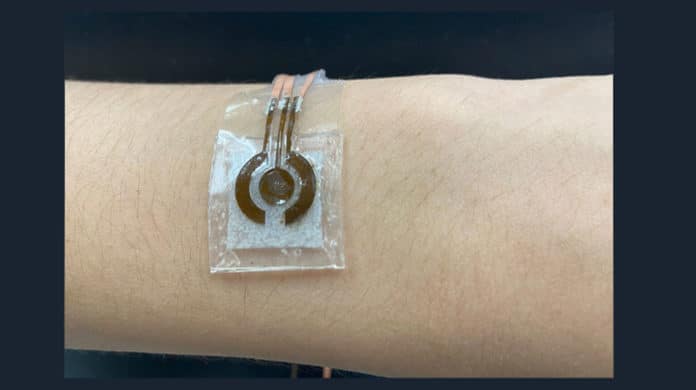People with diabetes either need to collect blood samples or embed sensors into their skin to monitor glucose levels. Both ways are painful.
Now, Penn State scientists have developed a new wearable device to measure blood sugar levels. The device is less intrusive, noninvasive, and low-cost. It is able to monitor glucose levels in sweat in Biosensors and Bioelectronics.
Scientists developed the device first with a material called laser-induced graphene (LIG). LIG is a material that consists of atom-thick carbon layers in various shapes. It has high electrical conductivity and a convenient fabrication time of just seconds. Hence, the material appeared to be an ideal framework for the sensing device — but there was a significant caveat.
Huanyu “Larry” Cheng, Dorothy Quiggle Career Development Professor in Penn State’s Department of Engineering Science and Mechanics, said, “The challenge here is that LIG is not sensitive to glucose at all. So, we needed to deposit a glucose-sensitive material onto the LIG.”
Scientists chose nickel as it has robust glucose sensitivity. They then combined it with gold to lower the potential risks of an allergic reaction.
Scientists noted, “The LIG outfitted with the nickel-gold alloy would be able to detect low concentrations of glucose in sweat on the skin’s surface.”
This nickel-gold alloy allowed scientists to exclude enzymes, which are used in other devices. These enzymes can degrade quickly with time and changing temperatures.
Cheng said, “A material with high glucose sensitivity was a priority. Sweat exhibits deficient glucose concentrations compared to blood — but, there is a strong correlation between glucose levels in sweat and blood. While the concentration of glucose in sweat is about 100 times less than the concentration in blood, the team’s device is sensitive enough to accurately monitoring glucose levels in sweat and reflect the concentration in blood.”
Scientists also attached a microfluidic chamber to the LIG alloy. This chamber promotes wearability and porous to allow for a range of movement, such as stretching or crushing. It is connected to a collection inlet that passes sweat into the solution without allowing the solution to touch the skin. The primary solution interacts with the glucose molecules to produce a compound that reacts with the alloy. This reaction triggers an electrical signal, indicating the concentration of glucose in the sweat.
Scientists shrank the size of the alkaline solution chamber. Hence, the entire device is roughly the size of a quarter and is flexible enough to maintain a secure attachment to the human body.
During testing, scientists used a skin-safe adhesive to attach the reusable device to a person’s arm one hour and three hours after a meal. The subject was asked to perform a brief workout to produce sweat. After few minutes of collecting samples, scientists found that the detected glucose concentration dropped from the first measurement to the next. The glucose measurements from the device were verified by measurements made with a commercially available glucose monitor.
Scientists are now looking forward to improving the device more for future applications. They also want to refine and expand this platform for more comfortable monitoring of other biomarkers found in sweat.
Cheng said, “We want to work with physicians and other health care providers to see how we can apply this technology for daily monitoring of a patient. This glucose sensor serves as a foundational example to show that we can improve the detection of biomarkers in sweat at deficient concentrations.”
Journal Reference:
- Jia Zhu, Hunayu Cheng et al. Laser-induced graphene non-enzymatic glucose sensors for on-body measurements. DOI: 10.1016/j.bios.2021.113606
